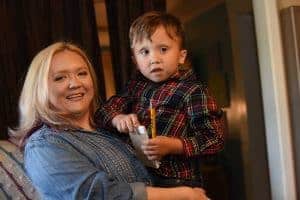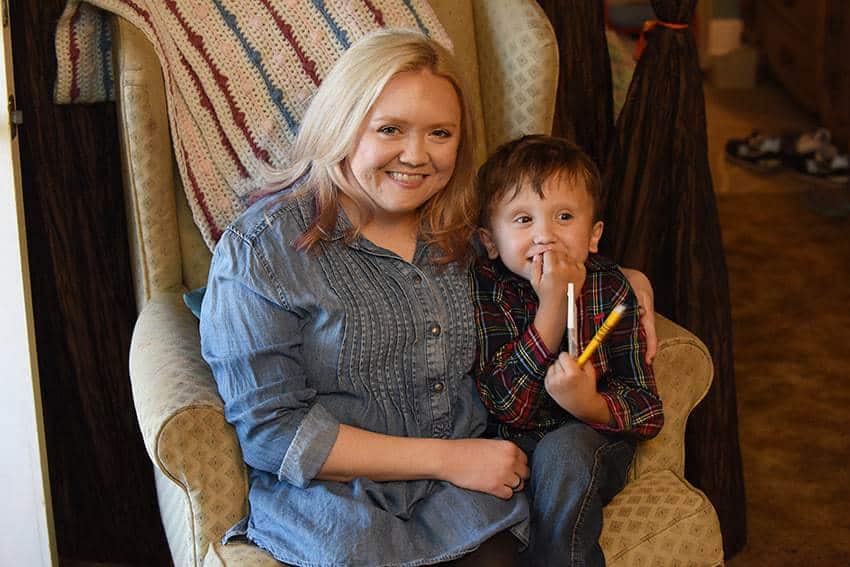Genetic Counselor Helps Patient Find Answers
| Dec. 22, 2017 | As a child, Laura Wright spent more than her fair share of time in the hospital.
She was born with a cleft palate and was diagnosed with Pierre Robin sequence, a condition in which children are born with a smaller than normal jaw, as well as a tongue that falls back in the throat and impedes breathing. Cleft palates are common with children who have Pierre Robin.
She also required several surgeries on her limbs as a child — something that doesn’t fall under a diagnosis of Pierre Robin.
It wasn’t until she was 27 years old and several weeks pregnant that Wright had a complete, accurate diagnosis.
She had campomelic dysplasia, a genetic condition that often results in short legs, dislocated hips, 11 pairs of ribs instead of 12 and clubfeet, among other symptoms, according to the U.S. National Library of Medicine. Distinctive facial features, such as a small chin, prominent eyes and a flat face, are typical of campomelic dysplasia — and Pierre Robin sequence is commonly seen in those with the disease.
Finally, Wright had answers.

Laura Wright holds her son, Lane. Both mother and son have campomelic dysplasia, a rare genetic condition.
She was also pregnant, and doctors were concerned about her baby’s development. At 17 weeks, her son Lane’s arms and legs were behind expected developmental milestones, and his head was measuring large. While his torso looked normal, his chest cavity looked small, Wright said.
Wright’s obstetrician Paul Wendel, M.D., sent her to the UAMS Prenatal Genetics Clinic. There she met Shannon Barringer, M.S., clinical services manager and a board-certified genetic counselor.
“When Laura walked in, I knew that she had something more serious than a cleft palate or Pierre Robin,” said Barringer. “In a way, genetic counselors are detectives. We are trained to look for specific features and medical histories that raise a big red flag. That was the case with Laura.”
After taking a complete medical history, Barringer and Wendel sent Wright to G. Bradley Schaefer, M.D., a UAMS geneticist, who made the campomelic dysplasia diagnosis.
“Shannon [Barringer] was with me when I received the diagnosis,” said Wright. “After Dr. Schaefer left the room, she took my hand and sat there with me. That meant more than any of the words she could have said.”
The next step for Barringer was giving Wright all of the information she needed to understand her disease, including the possible ramifications for her baby. Campomelic dysplasia is more often than not is associated with dying in infancy or at a young age, Barringer said.
“My first thought was would he be able to walk. I didn’t even think he could be born and not live,” said Wright. “Even though the team was worried about him, they didn’t let me know about that worry. They shouldered it themselves and laughed and helped me through it.”
Wright said she had mixed emotions about her diagnosis.
“Part of me was relieved to be diagnosed because I finally had an explanation for all of my medical issues. Part of me was scared because I was told Lane’s symptoms were more severe than mine were so we didn’t know what to expect,” she said.
“Throughout my pregnancy, I tried to maintain a calmness and remain positive so that even if he didn’t make it, he would be a happy baby when he was born.”
But Lane did make it.
Despite the expectation that Wright would go into labor early because of her small size (she’s only 4 foot 6) and the stress of the diagnosis, she carried Lane until he was 39 weeks old.
While he had a cleft palate at birth, none of Lane’s other health issues surfaced until he was six months old. At that time, he had surgery to widen his airway. At eight months old, doctors discovered he had difficulty swallowing (dysphagia) and gave him a gastrostomy button (G-button). Lane was fed exclusively through the button until he was 2 years old.
With 5 years and 10 surgeries under his belt, Lane is the happiest little boy, said Wright. “If you looked at him without knowing his medical history, you wouldn’t be able to see it.”
Wright said she is grateful for her team at UAMS.
“It was one of the hardest times of my life, but the compassionate care of Shannon and Dr. Wendel made it easier.”
